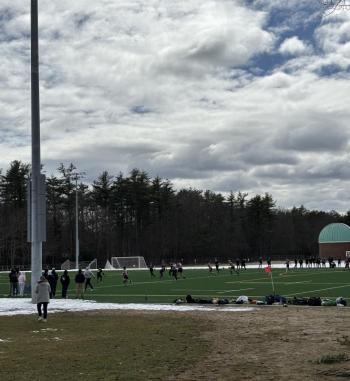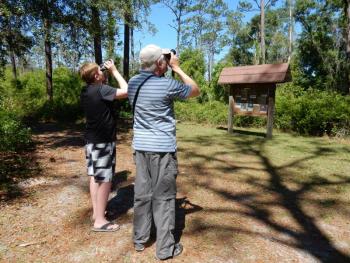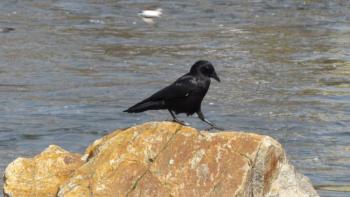Something Fishy Going On
The early April snowstorm left most surfaces, even a week later, with several inches of snow. But the rugby field on the Bowdoin College campus in Brunswick, where we went to watch our son play on the Bates team, was gleaming green. Once the games began, the field (and the players) quickly turned brown and muddy. The sounds of a rugby game are like many an athletic event—cheers, yells, claps, whistles, and, of course, the thumps and occasional groans of players in the thick of it.
Even within that soundscape, the birds didn’t stop making their own sounds. At one point, a phoebe began calling its name—“fwee-bwee, fwee-bwee”—our first of the spring!
American crows chased each other, perhaps fighting over a breeding spot among the many tall, fragrant white pines surrounding the fields. They gave their familiar “caw” calls.
And then there was something different. A crow call but short and nasal—the distinctive sounds of the American crow’s close relative, the fish crow.
The Bowdoin College campus has been the epicenter of the Maine fish crow scene since 1976. That’s the year that the species was first recorded in Maine in the so-called Bowdoin Pines adjacent to campus. The first confirmed nesting in the state came from the same area in 1978. The closest known nesting location at that time was over 100 miles to the south in Massachusetts.
Fish crows have continued to be found on and around the Bowdoin College campus in Brunswick since that time. For many years, this Brunswick population remained the only regular and confirmed breeding population in Maine. We remember how excited we were to travel down to the Bowdoin Pines and hear that distinctive, nasal “cah” in the early 1980s.
Fish crows have long been thought of as birds of the southern U.S. If you’ve ever been to Florida and paid attention to the sounds of crows, you likely heard lots of them. They range from eastern Texas and Oklahoma east to the Atlantic coast from Florida north (now) to southern Maine.
In the late 1980s, we moved to Ithaca, in upstate New York to begin our graduate studies at Cornell University. Soon we were delighted to discover that there was another isolated fish crow outpost. After a fish crow was first identified in Ithaca in 1974, more birds were seen there each year, and breeding was confirmed in 1979. Similar to the situation in Maine, this breeding population was more than 100 miles from the closest known breeding location to the south.
It seemed to take a few decades, but both here in Maine and in upstate New York, fish crows eventually began to be found in other locations. While still decidedly uncommon and highly localized here in Maine, fish crows are found in Portland and South Portland (we’ve had them near the malls there), Wells, Sanford, and Kennebunk. North of Brunswick they have been regularly found in the Waterville area (including, interestingly enough, on the Colby College campus), in Lewiston, Rockland, Belfast, and even in Bangor, Orono, and Ellsworth. There are other one-day sightings of single birds scattered across southern Maine but also lots of gaps where no one has identified one.
American crows can make very nasal calls during the breeding season, and young American crows, when begging for food, make all kinds of odd sounds—it’s very possible to confuse those sounds for fish crows. Fish crows do give a two-noted “UH-uh” version of their nasal call, which American crows don’t ever do, and even their regular, single-note calls are distinctive with experience. If you hear a funny, nasal-sounding crow, take out your phone and record the sound to attach to your eBird record or run it by the Merlin sound identification app. It may just confirm that there really is something fishy going on.
Jeffrey V. Wells, Ph.D., is a Fellow of the Cornell Lab of Ornithology and Vice President of Boreal Conservation for National Audubon. Dr. Wells is one of the nation's leading bird experts and conservation biologists. He is a coauthor of the seminal “Birds of Maine” book and author of the “Birder’s Conservation Handbook.” His grandfather, the late John Chase, was a columnist for the Boothbay Register for many years. Allison Childs Wells, formerly of the Cornell Lab of Ornithology, is a senior director at the Natural Resources Council of Maine, a nonprofit membership organization working statewide to protect the nature of Maine. Both are widely published natural history writers and are the authors of the popular books, “Maine’s Favorite Birds” (Tilbury House) and “Birds of Aruba, Bonaire, and Curaçao: A Site and Field Guide,” (Cornell University Press).
































